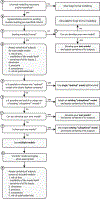GRADE Guidelines 30: the GRADE approach to assessing the certainty of modeled evidence-An overview in the context of health decision-making
- PMID: 32980429
- PMCID: PMC8514123
- DOI: 10.1016/j.jclinepi.2020.09.018
GRADE Guidelines 30: the GRADE approach to assessing the certainty of modeled evidence-An overview in the context of health decision-making
Abstract
Objectives: The objective of the study is to present the Grading of Recommendations Assessment, Development, and Evaluation (GRADE) conceptual approach to the assessment of certainty of evidence from modeling studies (i.e., certainty associated with model outputs).
Study design and setting: Expert consultations and an international multidisciplinary workshop informed development of a conceptual approach to assessing the certainty of evidence from models within the context of systematic reviews, health technology assessments, and health care decisions. The discussions also clarified selected concepts and terminology used in the GRADE approach and by the modeling community. Feedback from experts in a broad range of modeling and health care disciplines addressed the content validity of the approach.
Results: Workshop participants agreed that the domains determining the certainty of evidence previously identified in the GRADE approach (risk of bias, indirectness, inconsistency, imprecision, reporting bias, magnitude of an effect, dose-response relation, and the direction of residual confounding) also apply when assessing the certainty of evidence from models. The assessment depends on the nature of model inputs and the model itself and on whether one is evaluating evidence from a single model or multiple models. We propose a framework for selecting the best available evidence from models: 1) developing de novo, a model specific to the situation of interest, 2) identifying an existing model, the outputs of which provide the highest certainty evidence for the situation of interest, either "off-the-shelf" or after adaptation, and 3) using outputs from multiple models. We also present a summary of preferred terminology to facilitate communication among modeling and health care disciplines.
Conclusion: This conceptual GRADE approach provides a framework for using evidence from models in health decision-making and the assessment of certainty of evidence from a model or models. The GRADE Working Group and the modeling community are currently developing the detailed methods and related guidance for assessing specific domains determining the certainty of evidence from models across health care-related disciplines (e.g., therapeutic decision-making, toxicology, environmental health, and health economics).
Keywords: Certainty of evidence; GRADE; Guidelines; Health care Decision making; Mathematical models; Modelling studies.
Copyright © 2020. Published by Elsevier Inc.
Figures
References
-
- Oreskes N. The role of quantitative models in science. In: Canham CD, Cole JJ, Lauenroth WK, editors. Models in ecosystem science. Princeton, NJ: Princeton University Press; 2003:13–31.
-
- Frigg R, Hartmann S. Models in science. In: Zalta EN, editor. The Stanford Encyclopedia of Philosophy. Stanford, CA: Spring 2017 Edition; 2017.
-
- Briggs AH, Weinstein MC, Fenwick EA, Karnon J, Sculpher MJ, Paltiel AD, et al. Model parameter estimation and uncertainty: a report of the ISPOR-SMDM modeling good research practices task force–6. Value Health 2012;15:835–42. - PubMed
Publication types
MeSH terms
Grants and funding
LinkOut - more resources
Full Text Sources
Other Literature Sources


